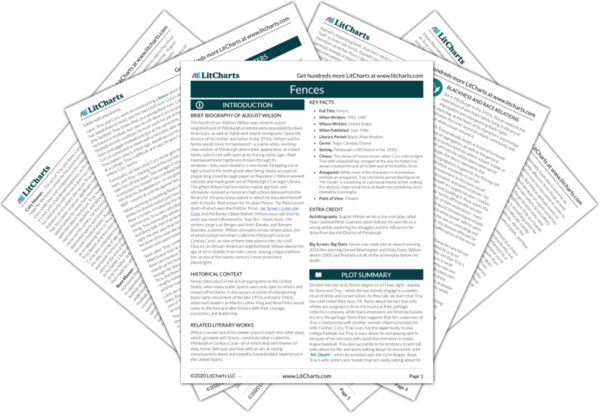
Welcome to the LitCharts study guide on August Wilson's Fences. Created by the original team behind SparkNotes, LitCharts are the world's best literature guides.
The fourth of six children, Wilson was raised in a poor neighborhood of Pittsburgh predominately populated by black Americans, as well as Italian and Jewish immigrants. Upon the divorce of his mother and father in the 1950s, Wilson and his family would move to Hazelwood—a mainly white, working-class section of Pittsburgh where their appearance, as a black family, wasn’t met with open arms. Facing racist rage—their Hazelwood home had bricks thrown through its windows—they soon moved to a new home. Dropping out of high school in the tenth grade after being falsely accused of plagiarizing a twenty-page paper on Napoleon I, Wilson worked odd jobs and made great use of Pittsburgh’s Carnegie Library. The gifted Wilson had learned to read at age four, and ultimately received an honorary high school diploma from the library for the precocious extent to which he educated himself with its books. Best known for his plays Fences , The Piano Lesson (both of which won the Pulitzer Prize), Joe Turner’s Come and Gone , and Ma Rainey’s Black Bottom , Wilson once said that his work was most influenced by “four B’s”—blues music, the writers Jorge Luis Borges and Amiri Baraka, and Romare Bearden, a painter. Wilson ultimately wrote sixteen plays, ten of which comprised what’s called his Pittsburgh Cycle (or Century Cycle ), as nine of them take place in the city’s Hill District, an African-American neighborhood. Wilson died at the age of 60 in Seattle, from liver cancer, leaving a legacy behind him as one of the 20th century’s most prominent playwrights.
Get the entire Fences LitChart as a printable PDF."My students can't get enough of your charts and their results have gone through the roof." -Graham S.

Fences takes place in the era of segregation in the United States, when many public spaces were only open to whites and closed-off to blacks. It also occurs at a time of a burgeoning black rights movement of the late 1950s and early 1960s. when such leaders as Martin Luther King and Rosa Parks would come to the fore and alter history with their courage, conviction, and leadership.
Wilson’s wrote (out of his sixteen plays in total) nine other plays which, grouped with Fences , constitute what’s called his Pittsburgh or Century Cycle— all of which deal with themes of duty, honor, betrayal, and love with an aim at raising consciousness about and empathy towards black experience in the United States.
Key Facts about FencesAutobiography. August Wilson wrote a one-man play called How I Learned What I Learned , which follows his own life as a young writer, exploring his struggles and the influences he drew from the Hill District of Pittsburgh.
Big Screen, Big Stars. Fences was made into an award-winning 2016 film starring Denzel Washington and Viola Davis. Wilson died in 2005, but finished a draft of the screenplay before his death.